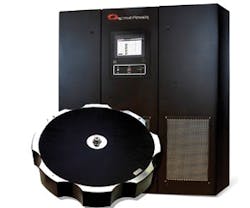If your equipment is mission critical, you already know the importance of maintaining a solid standby power plan in case a surge or spike hits. But how can you prevent data loss and corruption without sacrificing your company’s green goals? The answer: Pick a backup system that’s easier on the environment.
Deep Cycle Batteries
Some associate the classic battery with a short lifetime, odors, and dangerous, corrosive acid. But deep cycle batteries, which have heavier, thicker plates than starting batteries and constantly store energy, are 98% recyclable and can last upwards of a decade, says Tim Piercefield, a sales associate at Crown Battery Manufacturing. The only component that can’t be recycled is a thin rubber or paper separator.
"It’s old technology," Piercefield says. "There’s nothing new or sexy about it, but it works and it’s cost-effective."
Your main source of generation constantly tops off the batteries’ power storage. When the primary power source disappears, the batteries immediately start to discharge, providing a continuous flow of energy that gives you enough time to shut down your equipment or switch to a longer-lasting generator. A $50,000 setup that takes up as little as 250 square feet would be adequate for many businesses, Piercefield adds.
"People in general have a fear of batteries, thinking they’re going to give off odor and be unsafe," Piercefield says. "It’s a safe method that’s been around for years and years and has worked."
Flywheel Technology
This device stores kinetic energy from a 600-pound steel mass rotating rapidly in a vacuum, suspended inside its casing by a set of magnetic coils and powered by an electric motor. When the power source disappears, you can call on the flywheel to spend its stored energy to keep your system online long enough for you to shut everything down or switch to a generator.
The initial cost is slightly higher than a battery – about $55-60,000 for a single unit – but the highly efficient mechanism and 20-year life drive the lifetime costs down, says Martin Olsen, vice president and general manager of Active Power.
"If footprint or efficiency is an issue, it makes sense to look at a flywheel," Olsen says. "We’re green for a reason. Flywheels offer a 75% reduction in carbon footprint, directly derived from the efficiency itself."
Intended as a direct replacement for valve-regulated lead-acid batteries, the flywheel typically requires less space and can operate in a wider temperature range, adds Dann McKeraghan, vice president of sales for VYCON.
"When you deploy flywheel DC energy storage, you eliminate lead and acid from your facility," McKeraghan says. "Local codes vary on battery installations, but spill containment, ventilation, and eyewash stations are considerations. The flywheel eliminates these requirements."
Fuel Cells
Though they produce energy instead of storing it, fuel cells can play a starring role in your backup system as long as fuel is available, according to the Department of Energy. During Hurricane Isabel in 2003, fuel cells kept Maryland’s Elk Neck State Park wireless communications site running until utility power was restored.
Though some cells use natural gas, a fossil fuel, they use a chemical conversion process to create energy from the gas instead of burning it. This cuts carbon emissions by about 40%, says Nicole Elovitz, director of marketing for Clear Edge Power. A 5kW unit takes up about 35 square feet for installation and all clearances, but produces the equivalent amount of electricity as 3,000 square feet of solar panels, she adds.
The units can also reduce daily demand for utility power, as the power the cells create is provided to the building on the same line as power from the grid.
"The ability to generate power even when the sun is not shining and the wind is not blowing is critical," Elovitz adds.
The rapid growth of power consumption necessitates a hard look at efficiency, adds Brian Brickhouse, vice president of Eaton’s Critical Power Solutions division.
"You’ve got a pure financial reason to chase efficiency, but you have a sustainability reason as well," Brickhouse says. "Consuming less power is good for the world."
Janelle Penny ([email protected]) is associate editor of BUILDINGS.
About the Author
Janelle Penny
Editor-in-Chief at BUILDINGS
Janelle Penny has been with BUILDINGS since 2010. She is a two-time FOLIO: Eddie award winner who aims to deliver practical, actionable content for building owners and facilities professionals.

